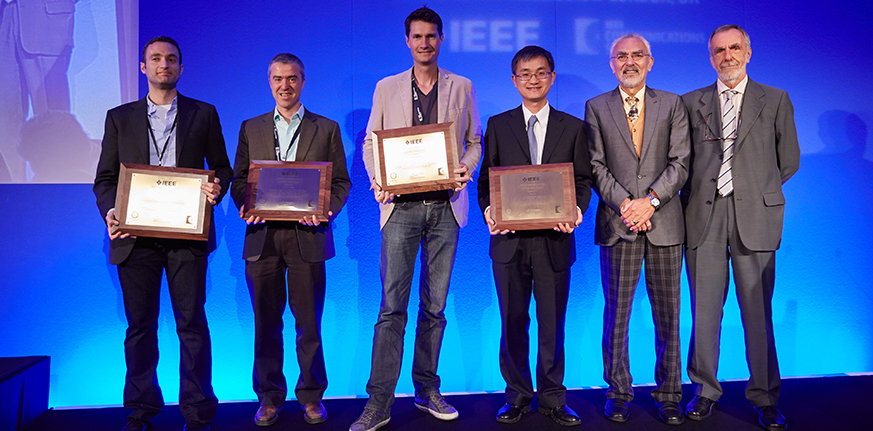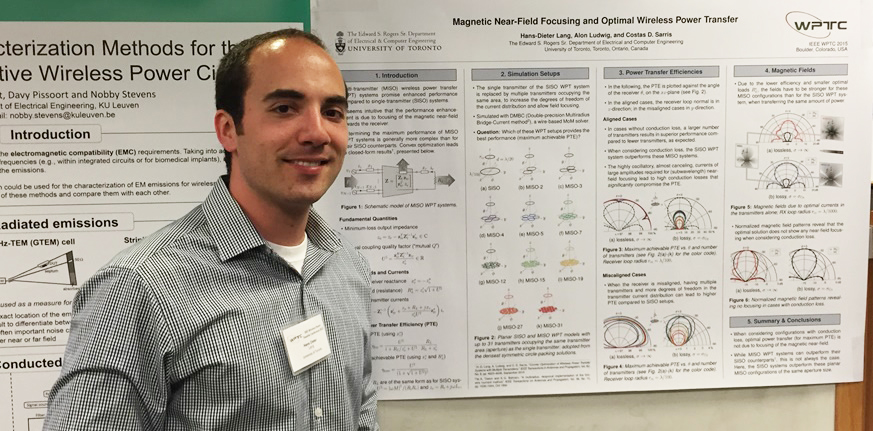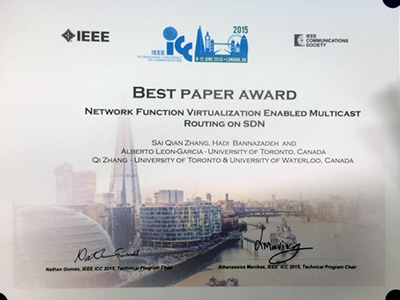June 19, 2015

Yu, co-authors receive IEEE Communications Society Best Tutorial Paper Award
A paper co-authored by Professor Wei Yu received The 2015 IEEE Communications Society Best Tutorial Paper Award. The award was given at IEEE International Conference on Communications held June 8-12, 2015, in London, U.K.
Titled “Multi-Cell MIMO Cooperative Networks: A New Look at Interference,” and published in IEEE Journal on Selected Areas in Communications in December 2010, the tutorial paper has had significant influence on research and development of cooperative wireless cellular communication systems. It introduces channel models, fundamental capacity limits, system optimization techniques, and practical implementation considerations for cooperative communications. Since its initial publication, the paper has become a standard reference and remains the most comprehensive survey in this active research area.
The paper is co-authored by leading experts from both academia and industry, spanning a spectrum of research expertise from information theory, communication system design, optimization, signal processing and practical implementation. With this award, the authors were particularly recognized for their success in covering the relevant subjects in a cohesive manner, making the tutorial accessible to both theoreticians and practically oriented engineers.
The considerable impact of this tutorial paper is evident from its citation record: it has been cited over 900 times according to Google Scholar as of June 2015, making it the most highly cited paper among all papers published by the IEEE Communications Society in the past five years.

Lang wins student paper award at IEEE Wireless Power Transfer
Wish your phone could charge itself while it’s sitting in your pocket? Or that you could power your TV, laptop and other devices wirelessly altogether? These visions of wireless power transfer, commonly appearing in newspapers and magazines, are still quite futuristic. Currently available solutions still look quite different; besides some industrial applications, merely charging pads for mobile phones are on the market.
“This is mostly due to the fact that the efficiency at which the power can be transferred to the receiver is not high enough.” says Lang.
Lang is a PhD candidate in The Edward S. Rogers Sr. Department of Electrical & Computer Engineering at the University of Toronto, working under the supervision of Professor Costas Sarris. His research on wireless power transfer garnered Lang the second best student paper award at the 2015 IEEE Wireless Power Transfer Conference in Boulder, Colorado, for his paper titled “Magnetic Near-Field Focusing and Optimal Wireless Power Transfer.”
Lang’s work tackles a common misconception of systems that combine multiple transmitters to achieve higher transfer efficiency. It seems that various researchers still believe that coupling multiple transmitters generally leads to better performance because the magnetic field is focused and can be steered towards the receiver.
If the transmitters were lossless, this would indeed be the case. Lang however, discovered that in reality, when the transmitter antennas are made of actual metal, exhibiting conduction loss, this field focusing is not feasible. To focus the magnetic field, essentially all the contributions of each of the transmitters have to cancel everywhere but in the direction of the receiver. However, to still obtain a strong enough field at the receiver location, the currents in the transmitters have to be very high; thus, leading to high losses, which decrease the overall performance so much that this operating mode is not feasible. In the most efficient mode of operation, the magnetic fields look very similar to those of a single-transmitter system.
However, having multiple transmitters helps in regions which generally exhibit low power transfer efficiency, for example when the receiver is misaligned. In those cases, multi-transmitter systems can actually achieve substantially better performance than single-transmitter systems. Thus, overall, wireless power transfer systems with multiple transmitters can indeed outperform single-transmitter systems, particularly in practical use cases when the receiver is mobile. Lang presented efficient algorithms for the design of such multi-transmitter power transfer systems for optimal efficiency. He also showed that this optimality has nothing to do with field focusing: the transmitter operates as a “fountain” rather than a “hose”.
“The results were puzzling to some people,” says Lang. “And to other people it simply confirmed their suspicions.”
Abdelfattah, Bitar, Betz win best paper award at ACM/SIGDA International Symposium on FPGAs
ECE PhD candidate Mohamed Abdelfattah, MASc student Andrew Bitar and Professor Vaughn Betz, won the best paper award at the 23rd ACM/SIGDA International Symposium on Field-Programmable Gate Arrays, on Feb. 26, 2015.
The conference, held in Monterey, California, is a destination for presentation of advances in all areas related to FPGA technology. University of Toronto has a strong history there, and a reputation as one of the most active FPGA groups in the world. Three out of the 20 papers presented at the conference came from U of T.
Abdelfattah says he is very content to see the rising interest in his paper from different FPGA commercial vendors. “One and a half years ago they were sceptical,” he says. “Today they are seeking ways to apply this new communications architecture to their work.”
 Zhang, Bannazadeh, Leon-Garcia win best paper award at IEEE ICC 2015
Zhang, Bannazadeh, Leon-Garcia win best paper award at IEEE ICC 2015
Master’s candidate Sai Qian Zhang, Hadi Bannazadeh and Professor Alberto Leon-Garcia were recognized with a best paper award at the IEEE International Conference on Communications hosted in London, U.K. from June 1-8, 2015. The paper, titled “Network Function Virtualization Enabled Multicast Routing on SDN,” was also co-authored by Qi Zhang of both UofT and the University of Waterloo.
“Software-defined networks is an area of intense interest because it changes how networks are designed and operated,” said Professor Leon-Garcia. “Sai developed algorithms for the placement of ‘virtual network functions’ in a software-defined infrastructure. His paper stood out because it combined theoretical, simulation, and an experimental evaluation of algorithms in an important problem area.”
Ehsan, Adve win best paper award at Backnets 2015
A paper co-authored by former ECE post-doctoral fellow Ehsan Karamad and Professor Raviraj Adve, along with industrial partners from SIRADEL North America, Yves Lostanlen, Florian Letourneux and Sylvain Guivarch, won the best paper award at Backnets 2015, an international workshop on Backhaul Networks. The paper, titled “Optimizing Placement of Backhaul Hubs and Orientations of Antennas in Small Cell Networks”, was presented as part of the IEEE International Conference on Communications in London, U.K. from June 1-8, 2015.
More information:
Mireille Khreich
Communications Assistant
The Edward S. Rogers Sr. Department of Electrical & Computer Engineering
416-978-1999; mireille.khreich@utoronto.ca